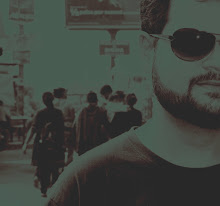 |
| Locked Everywhere! |
Death, for teenagers, is a
romantic idea. As Dhamani Ghosh (Sabyasachi Chakraborty) in Hemlock Society says that every one of
us has romanticized and attempted suicide in our teens. True. But the film makes you realise how selfish and self-centred we have become. Grab the moment and live the "now and then". That’s precisely what the film tries
to say. However, I was not very sure
whether I should write on this particular film. Let me give you the three reasons:
Koel. I was not very sure exactly
what to write about her. I am not a great writer as it is and moreover I was
intimidated by my fellow viewers who have provided me with a mixed reaction.
Srijit. I was scared and kept my
fingers crossed. Autograph had earned
him a name overnight. 22shey Srabon
was received with open arms. I prayed for his third to work. So, I decided to
keep mum.
Simplicity. We have become prone
to complexities. The more complex a tale and its narrative is the better for
us. The simpler the fact and the narrative, the worse. Hemlock Society has a simple message and in the comparisons and
contrasts, we are perhaps missing out the fun.
But then I thought, why not! So I decided to list ten reasons for liking the movie and its drawbacks too:
1.The Hemlock Society, USA was a national right-to-die
organization founded in Santa Monica, California by Derek Humphry in 1980. Its primary missions included providing information to dying
persons and supporting legislation permitting physician-assisted suicide. In
1992, following the publication of his book Final Exit Derek Humphry left the leadership of Hemlock Society
USA. In 2003 the national organization renamed itself, and a year later merged
with another group into a newly formed national organization called Compassion and Choices.. A number of unaffiliated local organizations continue to operate under
variants of the Hemlock
Society name. Srijit’s title
is ambiguous. It is just the contrary to what it highlights. Suicide can never
be an option, it never was. Well researched.
2. My
heart aches, and a drowsy numbness pains,
My sense, as though of hemlock I had
drunk,
Or emptied some dull opiate to the drains
One minute past, and Lethe-wards had
sunk:
John Keats. Ode to a Nightingale. The title heavily borrows from the lines by
one of the most adorable Romantic poets. Life has always been a tale of “fever
and fret” and hemlock, a metaphor for addiction, is a respite and an escape,
any day. As the film opens, the title flashes on a glass brimming with a drink
and ice cubes. Hemlock Society speaks
of the futility of inebriation. Remember Porter?
Marry, sir, nose-painting, sleep, and urine. Lechery, sir, it
provokes and unprovokes. It provokes the desire, but it takes away the
performance. Therefore, much drink may be said to be an equivocator with
lechery. It makes him, and it mars him; it sets him on, and it takes him off;
it persuades him, and disheartens him; makes him stand to and not stand to; in
conclusion, equivocates him in a sleep, and, giving him the lie, leaves him.
(Macbeth)
3. References to figures, mostly from literature, who had
committed suicide. And a special mention of Derrida. The director subtly tells
you, he is “deconstructing” every idea about contemporary Bengali movie. And
perhaps, his own image.
4. The director brings back wit. The names assigned to the
professors who coach the candidates, remind you of the names from the Comedy of
Manners. Bengalees love subtlety and Hemlock
mesmerizes with its subtle take on humour, wit and irony of life.
5. Parambrata is the winner all the way. The best lines are
written for him and even the expletive seems music to the ears!
6. Roopa Ganguly-Dipankar De track is all flesh and blood.
Neither sugary, nor nyaka, the duo
provides a lifetime performance. Chitto and Niharika are real.
7. The music will receive its due as the days go by. The film
has been completed within a low budget and the director has taken exactly nine
months to release the film after 22shey
Srabon which was released almost a year after Autograph. Time constraints have marred the publicity this time.
Else Anupam’s Ekhon Anek Raat, Ei To Ami Chai and Jol Phoring would have been
chartbusters already.
8. The extensive and detailed use of colours and a
commendable production design are added gems to the movie.
9. Srijit’s continuous references to old as well as new Hindi
movies. His indebtedness to Tolly, Holly and Bolly has been reflected in his
earlier works. Hemlock is no
exception.
10. Koel is the girl in question. Having watched her in Nater Guru, Saat Panke Baadha, Subho
Drishti, Paglu, Debipokhkho and a few more. I believe
she needs a good director to get her dues. The effort, on the part of a
director, to merge “two contrary” starts of Tolly’s soul is a laudable job
done. Parambrata takes care of her follies. Let her grow up viewers!
And now, the disappointments.
135 minutes is a long time for Hemlock. Crisp and edgy design is the director’s forte. He
compromises this time, to get his cyclical narrative established. Major work in
terms of editing would have been great.
DOP, Soumik Halder seems to be obsessed with the camera
movements. The continuous jerky movement is unnecessary and tiring after a
certain point of time.And Saheb Chattopaddhay is a royal pain!
A film thrives on its own merit. Recommendations or reviews take away the essence of a film. Hemlock
Society does not promise to be a thrilling and nail-biting sequel to 22shey Srabon. It is intelligent and
quirky.The shortcomings can be forgiven and forgotten once you drown yourselves in the shores of Lethe.
As for you, ROPE, DOPE or HOPE? The choice is yours!
